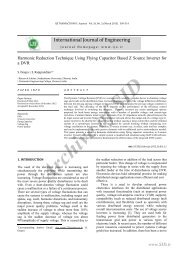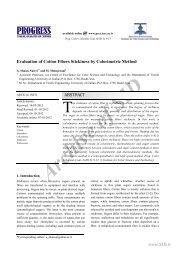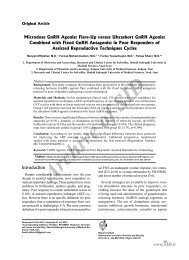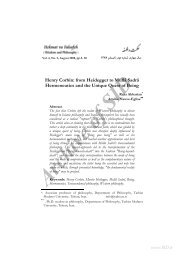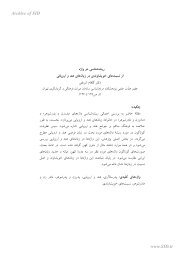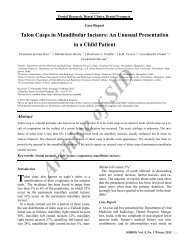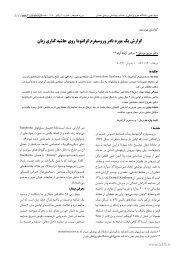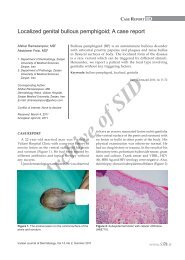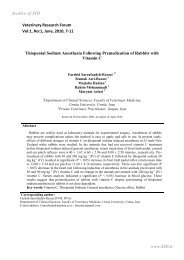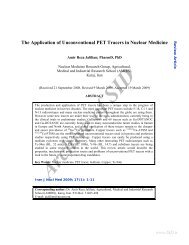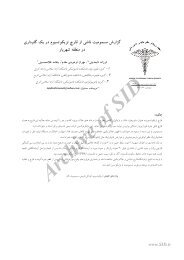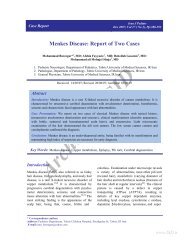A REVISION OF SENECIO L. (ASTERACEAE, SENECIONEAE), IN ...
A REVISION OF SENECIO L. (ASTERACEAE, SENECIONEAE), IN ...
A REVISION OF SENECIO L. (ASTERACEAE, SENECIONEAE), IN ...
Create successful ePaper yourself
Turn your PDF publications into a flip-book with our unique Google optimized e-Paper software.
A <strong>REVISION</strong> <strong>OF</strong> <strong>SENECIO</strong> L. (<strong>ASTERACEAE</strong>, <strong>SENECIO</strong>NEAE), <strong>IN</strong> IRAN<br />
E. Lotfi, M. Yousofi & M. Assadi<br />
Received 20 02 2010. Accepted for publication 12 05 2010<br />
Lotfi, E., Yousofi, M. & Assadi, M. 2010 06 30: A revision of Senecio L. (Asteraceae, Senecioneae), in Iran. -Iran.<br />
J. Bot. 16 (1): 96-106. Tehran.<br />
The genus Senecio L. is reviewed based on the literature and available herbarium materials. A synopsis and<br />
identification key is provided to the 22 accepted taxa. Diversity centers and distribution maps of Senecio species in<br />
Iran are presented. Also the checklist of accepted species and synonyms including selected studied specimens are<br />
given. Furthermore, Senecio erucifolius subsp. erucifolius which has been collected from Azerbaijan province is<br />
reported as a new subspecies to Iran. This subspecies is compared with closely related subspecies S. erucifolius<br />
subsp. grandidentatus.<br />
Elahe Lotfi (correspondence), Science Faculty, Payame Noor University, Najaf Abad Center, Najaf Abad. – Mehdi<br />
Yousefi, Payam Noor University of Isfahan, Department of Biology, P. O. Box 81395-671, Ashrafi Isfahani Blvd.,<br />
Isfahan, Iran. E-mail: muosofi@yahoo.com. Mostafa Assadi, Department of Botany, Research Institute of Forests<br />
and Rangelands, Tehran, Iran.<br />
Key words. Senecio, synopsis, Iran, taxonomy, new record, flora.<br />
<br />
Senecio L. (Asteraceae, Senecioneae)<br />
. <br />
<br />
<br />
. <br />
<br />
. <br />
Archive of SID<br />
<br />
<br />
<br />
<br />
. <br />
<br />
22 <br />
. <br />
<br />
Senecio <br />
<br />
<br />
<br />
<br />
<br />
<br />
<br />
S. erucifolius subsp. erucifolius<br />
. <br />
<br />
. S. erucifolius subsp. grandidentatus <br />
. <br />
<br />
<br />
<strong>IN</strong>TRODUCTION<br />
The first author has been revising the tribe Senecioneae<br />
in Iran for her M. S. thesis and also draft of Flora of<br />
Iran (Assadi 1989). Senecio L. (Asteraceae,<br />
Senecioneae) is the largest genus of Asteraceae in the<br />
world with about 1500 species and with worldwide<br />
distribution (Matthews 1975). The species are<br />
distributed all over the world, especially in South<br />
Africa, Mediterranean floristic region and in temperate<br />
areas of Asia and America (Schischkin 1961).<br />
Nordenstam (1989) transferred some species of Senecio<br />
into the genus Iranecio B. Nord. and introduced 4<br />
sections and 17 taxa including species and subspecies<br />
of this genus in Iran. The genus Senecio after<br />
Nordenstam (1989) draft of Flora Iranica has been<br />
subject of several studies, partly circumscription of the<br />
genus have been changed. Jeffrey (1992) based on<br />
anatomy character transferred species that belonged to<br />
Senecio Sect. Quadridentati Boiss. to the genus<br />
Iranecio. Also Pelser et al. (2006) and Nordenstam<br />
(2006) based on molecular systematic studies and<br />
Pelser et al. (2007) based on ITS phylogeny studies<br />
regarded the section Jacobaea (Mill.) Dumort. as a<br />
distinct genus, but as the circumscription of these<br />
groups are not quite clear and it has not been stabilized<br />
yet, in this paper only the genus Senecio sensu<br />
Nordenstam (1989) has been subject of studies and the<br />
genus Jacobaea Mill. is included in the genus Senecio.<br />
Phytogeographically, the majority of the species of<br />
Senecio are found in Irano-Turanian region, a few<br />
species are found in Saharo-Sindian region and one<br />
species is found in Hyrcanian province of Euro-<br />
Siberian region. Some species of this genus have a<br />
limited distribution in Iran and grow individually or in<br />
the small isolated patches. These species are usually<br />
very rare or can be endangered. But some species, such<br />
www.SID.ir
97 Senecio in Iran IRAN. JOURN. BOT. 16 (1), 2010<br />
Table 1. Comparison of the number of species and endemics of Senecio L. in Iran and some neighboring countries.<br />
Country No. of species No. of endemics<br />
Iran 21 6<br />
Iraq 6 -<br />
Turkey 42 15<br />
Turkmenistan 3 -<br />
Pakistan 7 -<br />
Afghanistan 8 -<br />
Armenia 2 -<br />
as S. glaucus L., S. vulgaris L. and S. vernalis Waldst<br />
& Kit. (sect. Senecio), have widespread distribution in<br />
the country.<br />
The aim of this paper is to revise the taxonomy of<br />
the genus in Iran, to present an identification key to the<br />
known taxa to Iran, and to give the sequence of the<br />
species and to report a new record of Senecio for Iran.<br />
MATERIAL AND METHODS<br />
By using existing Floras about 700 herbarium<br />
specimens in the herbarium of Research Institute of<br />
Forests and Rangelands (TARI), herbarium of Iranian<br />
Research Institute of Plant Protection (IRAN),<br />
herbarium of Ferdowsi University of Mashhad<br />
(FUMH), herbarium of Research Center of Natural<br />
Resources of Isfahan, herbarium of Tarbiat Moallem<br />
University (FAR) and herbarium of Department of<br />
Biology of Isfahan University were examined and were<br />
determined (taxonomically and morphologically).<br />
RESULTS<br />
In this paper the number of Senecio taxa increasing to<br />
22, among them 6 species are endemic to Iran. The<br />
number of species and endemics of this genus in Iran<br />
and other neighboring countries are compared in table<br />
1. The name of three species are excluded from the list<br />
of flora of Iran.<br />
Checklist of Senecio L. species<br />
Sect. Crociseris (Reichenb.) Hall & Wohlf. in W. D.<br />
Koch, Syn. Deut. Schweiz. Fl. ed. 3: 1486 (1897).<br />
Archive of SID<br />
Syn.: Senecio L. sect. Crociserides DC., Prodr. 6: 357<br />
(1838).<br />
Plants perennial. Leaves oblanceolate or lanceolate,<br />
entire or pinnatifid. Capitula radiate or only with<br />
tubular flowers; tubular flowers with 5 teeth. Pappus<br />
persistent.<br />
1. Senecio pseudo-orientalis Schischk., Fl. URSS. 26:<br />
727 (1961).<br />
Syn.: S. orientalis Willd., Spec. Plant. 3: 2006 (1803)<br />
non Miller (1768).<br />
Type: Armenia.<br />
Some studied specimens: Azerbaijan, Mianeh to<br />
Tabriz, 1000 m, Sabeti 5606 (TARI); Tehran, 16 km<br />
Gazvin to Alamot, 2000-2300 m, Assadi & Maassoumi<br />
50943 (TARI); Hamedan; Kabodar Ahang, 2200-2800<br />
m, Mozaffarian 64565 (TARI); Isfahan; Booien dareh<br />
to Khalat, 2600 m, Feyzi, Saeidfar & Eftekhari 6304.<br />
Map 1.<br />
Typical characters: Base of stem woolly. Involucral<br />
bracts 14-18 in number.<br />
2. S. doriiformis subsp. orientalis (Fenzl) Matthews,<br />
Notes Roy. Bot. Gard. Edinb. 33: 434 (1975).<br />
Syn.: S. doriaeformis DC. var. megalophron Boiss., Fl.<br />
Or. 3: 407 (1875).<br />
Type: Turkey.<br />
Studied specimens: Kurdestan, between Nusud and<br />
Marivan, 2000 m, Mazaffarian 74827 (TARI);<br />
Kermanshah, Paveh, Shaho mountain, 1300-2000 m,<br />
Tavakoli & Mirabdali 2900 (TARI). Map 1.<br />
Typical characters: Base of stem woolly. Involucral<br />
bracts 12- 13 in number.<br />
3. S. racemosus (M.B.) DC., Prodr. 6: 338 (1838).<br />
Type: Caucasus.<br />
Studied specimen: Azerbaijan, 5 km Ardebil to Astara,<br />
1300 m, Assadi & Akhani 61640 (TARI). Map 2.<br />
Typical character: Synflorescence racemeose.<br />
4. S. thyrsophorus C. Koch, Linnaea 24: 362 (1851).<br />
Type: Caucasus.<br />
Studied specimens: Azerbaijan, 3o km Tabriz,<br />
Eskandar village, Eskandar mountain, 1700-2100 m,<br />
Mozaffarian & Mohammadi 37563 (TARI); Kurdestan,<br />
40 km Divan dareh to Sagez, 2100 m, Mozaffarian<br />
77155 (TARI). Map 2.<br />
Typical character: Synflorescence paniculate.<br />
Note: In Flora Iranica (Nordenstan 1989) in agreement<br />
with Matthews (1975) S. thyrsophorus were regarded<br />
as synonymous of S. racemosus, but in this<br />
investigation based on the study of herbarium<br />
specimens the synflorescence seems to be a reliable<br />
character for distinction of these two species.<br />
5. S. paulsenii subsp. khorasanicus (Rech. f. & Aell.)<br />
B. Nord., Flora Iranica 164: 68 (1989).<br />
Syn.: S. khorasanicus Rech.f. & Aell., Osterr. Bot.<br />
Zeitschr. 97: 236 (1950).<br />
Type: Iran: Khorasan.<br />
www.SID.ir
IRAN. JOURN. BOT. 16 (1), 2010 Lotfi, Yousofi & Assadi 98<br />
Some studied specimens: Azerbaijan, Tabriz to Moshk<br />
anbar, 1770 m, Mozaffarian 87147 (TARI); Tehran,<br />
Gazvin, Abegarm, 1974 m, Mozaffarian 87302(TARI);<br />
Semnan, between Semnan and Firuz kuh, 2450 m,<br />
Wendelbo & Assadi 29768 (TARI); Khorasan, E.<br />
Esfarayen, Sarigol National Park, Kalate Narimani,<br />
1746 m, Joharchi & Zangoii 39828 (FUMH). Map 3.<br />
Typical characters: Plant sparsely arachnoid,<br />
arachnoid-floccose to subglabrous. Phyllaries 15-22,<br />
11-15 × 1.5-3 mm. Limb of ray flowers 12-25 mm<br />
long. Tube of ray flowers 6-10 mm long. Disk flowers<br />
35-60 in nunber and 10-15 mm long.<br />
6. S. joharchii F. Ghahremaninjad, Ezazi, Rahchamani<br />
& Attar, Feddes Repert. 121(1-2): 27-31 (2010).<br />
Type: Iran: Khorasan. Endemic.<br />
Studied specimen: Northern Khorasan, Esfarayen,<br />
Saluk National Park, Mt. Ahangaran, 1861 m, Ezazi &<br />
Rahchamani 4692 (FAR). Rare. Map 3.<br />
Typical characters: Plant densely arachnoid floccose.<br />
Phyllaries 32-35, 9-10 × 0.8-1 mm. Limb of ray<br />
flowers 6-7 mm long. Tube of ray flowers 2 mm long.<br />
Disk flowers ca. 80 in number and 3-5 mm long.<br />
Sect. Quadridentati Boiss., Fl. Or. 3: 385 (1875).<br />
Plants perennial. Leaves obovate or lyrate,<br />
pinnatipartite or pinnatisect. Capitula radiate; tubular<br />
flowers 4 dentate. Pappus persistent.<br />
7. S. taraxacifolius (M. B.) DC., Prodr. 6: 348 (1838).<br />
Syn.: Cineraria taraxacifolia M.B., Fl. Taur.-Cauc. 2:<br />
313 (1808); Ligularia aucheri DC., Prodr. 7: 300<br />
(1838); Iranecio taraxacifolius (M. B.) C.Jeffrey, Kew<br />
Bull. 47 (1): 103 (1992).<br />
Type: Caucasus.<br />
Studied specimens: Azerbaijan, Sabalan, Shah bil,<br />
3000-3570 m, Mozaffarian 87588 (TARI); Sabalan<br />
mountain, 3340 m, Rejamand 6745 (TARI). Map 4.<br />
Typical characters: Stem 30 cm high. Leaves with 1-3<br />
pairs of lobes; terminal lobe longer.<br />
8. S. davisii Matthews, Notes Roy. Bot. Gard. Edinb.<br />
33: 259 (1974).<br />
Syn.: Iranecio davisii (Matthews) C. Jeffrey, Kew Bull.<br />
47 (1): 102 (1992).<br />
Type: Caucasus.<br />
Archive of SID<br />
Studied specimens: Azerbaijan, Urumieh, Khalil kuh,<br />
2450-3155 m, Mozaffarian 87446 (TARI); Uromeieh,<br />
2400 m, Sabeti 4147 (TARI); Urumieh, Silvana, 2600-<br />
3000 m, Mozaffarian 69903 (TARI). Map 4.<br />
Typical characters: Stem 70 cm high. Leaves with 4-8<br />
pairs of lobes; terminal lobe equaling the other lobes.<br />
9. S. lipskyi Lomak., Trav. Jard. Bot. Tiflis 3: 51<br />
(1899).<br />
Syn.: S. saxatilis Lomak., l. c. 2: 287 (1897) non Wall.<br />
ex DC., Prodr. 6: 367 (1838); Iranecio lipskyi (Lomak.)<br />
C. Jeffrey, Kew Bull. 47 (1): 103 (1992).<br />
Type: Caucasus.<br />
Some studied specimens: Azerbaijan, Marand, Misho<br />
dagh mountain, 2000 m, Assadi 78964 (TARI); 20 Km<br />
South Ahar to Tabriz, 1700-1800 m, Wendelbo &<br />
Assadi 27923 (TARI). Map 5.<br />
Typical character: Achenes pubescent.<br />
10. S. lorentii Hochst. in Lorent, Wanderungen, 330<br />
(1845) et in Flora 28: 27 (1845).<br />
Syn.: Iranecio lorentii (Hochst.) C. Jeffrey, Kew Bull.<br />
47 (1): 103 (1992).<br />
Type: Turkey.<br />
No specimen was found among the herbarium<br />
specimens. It has been recorded from Kurdestan<br />
province without exact locality (cf. Nordenstam 1989).<br />
Map 5.<br />
Typical character: Achenes glabrous.<br />
Sect. Jacobaea (Mill.) Dumort., Fl. Belg. 65 (1827).<br />
Syn.: Jacobaea Mill., Gard. Dict. Abr. ed. 4 (1754).<br />
Plants perennial. Leaves obovate or oblanceolate,<br />
pinnatifid or pinnatisect. Capitula radiate; tubular<br />
flowers 5 dentate. Pappus persistent or temporary.<br />
11. S. mollis Willd., Sp. Pl. 3: 2011 (1803).<br />
Syn.: S. hebespermus DC., Prodr. 7: 301 (1838);<br />
Jacobaea mollis (Willd.) B. Nord., Comp. Newslet. 44:<br />
12 (2006).<br />
Type: Anatolia.<br />
Some studied specimens: Azerbaijan, Arasbaran, 1200<br />
m, Hamzee & Asri 81365 (TARI); Kurdestan, Divan<br />
dareh, Chehel cheshme mountain, 2000-2750 m,<br />
Mozaffarian79853 (TARI); Lorestan, Borojerd, 1480<br />
m, Karimi 2431 (TARI); Isfahan, Fereidan, Varzaneh,<br />
2200 m, Feyzi 12358; Tehran, Karaj, Dashteh, 1910 m,<br />
Foroughi 935 (TARI). Map 6.<br />
Typical characters: Leaf margin smooth. Achenes with<br />
glossy pubescent.<br />
12. S. erucifolius L., Sp. Pl. 869 (1753).<br />
subsp. erucifolius (Fig. 1).<br />
Syn.: Jacobaea erucifolia (L.) G. Gaertn., B. Mey. &<br />
Schreb., Oeken Fl. Wetteran 3 (1): 208 (1801).<br />
Type: Caucasus.<br />
Studied specimens: Azerbaijan, W. Salmas,<br />
Pereshkhoran, border of Turkey, 2100 m, Mozaffarian<br />
96947 (TARI); 50 km W. Khoy, near to Turkey, 2800<br />
m, Assadi & Olfat 68793 (TARI). Map 6.<br />
Typical characters: Basal and stem leaves present,<br />
oblanceolate, dorsal surface glabrous, green. Capitula<br />
7-13.<br />
This subspecies is recorded from Iran for the first<br />
time. In Flora Orientalis (Boissier 1875) S. erucifolius<br />
includes two taxa: β latilobus , γ grandidentatus. In<br />
Flora URSS (Schischkin 1961) S. erucifolius latilobus<br />
was regarded as a synonym of S. schischkinianus.The<br />
present species with bipinnatisect leaves and endemic<br />
distribution in Caucasus (described from Daghestan) is<br />
www.SID.ir
99 Senecio in Iran IRAN. JOURN. BOT. 16 (1), 2010<br />
Archive of SID<br />
Fig . 1. Senecio erucifolius subsp. erucifolius (×0.5); capitula (×1.5) ray and disk flowers (×2).<br />
www.SID.ir
IRAN. JOURN. BOT. 16 (1), 2010 Lotfi, Yousofi & Assadi 100<br />
Table 2. Diagnostic characters of the subspecies of Senecio erucifolius.<br />
Characters Leaf division Leaf indument Capitula number<br />
Subspecies<br />
subsp. erucifolius Lanceolate- pinnatisect Glabrous<br />
7-13<br />
subsp. grandidentatus Pinnatifid<br />
hairy grey<br />
16-90<br />
separable from our specimens. In Flora de lIran (Parsa<br />
1943) S. erucifolius var latilobus was reported from<br />
Tehran. This area is close to the distribution of S.<br />
erucifolius subsp. grandidentatus, therefore Parsa (l. c.)<br />
record may be a misidentification of S. erucifolius<br />
subsp. grandidentatus.<br />
In Flora URSS (Schischkin 1961), Flora of Turkey<br />
(Matthews 1975) and Flora Europaea (Chater &<br />
Walters 1976) Senecio erucifolius and Senecio<br />
grandidentatus are known as two distinct, but in Flora<br />
Iranica S. grandidentatus was reduced to a subspecific<br />
rank named S. erucifolius subsp. grandidentatus for the<br />
first time.<br />
The closest locality to the Iranian gathering of S.<br />
erucifolius subsp. erucifoilius seems to be in E.<br />
Anatolia (Matthews 1975).<br />
S. erucifolius subsp. erucifolius (Fig. 1) is compared<br />
with closely related subspecies, S. erucifolius subsp.<br />
grandidentatus (Ledeb.) B. Nord. in Table 2.<br />
subsp. grandidentatus (Ledeb.) B. Nord., Flora Iranica.<br />
164: 76 (1989).<br />
Syn.: S. grandidentatus Ledeb., Fl. Ross. 2: 636 (1845).<br />
Type: Caucasus.<br />
Studied specimens: Mazandaran, Firuzkuh to Ghaem<br />
Shahr, Duab, 700 m, Mozaffarian 77354 (TARI);<br />
Gorgan, Zarin Gol, 850 m, Riazi 6711 (TARI). Map 6.<br />
Typical characters: Stem leaves only present, elliptic or<br />
obovate, pinnatifid, dorsal surface densely hairy, grey.<br />
Capitula 18-90.<br />
Sect. Senecio<br />
Syn.: Sect. Obaejacae DC., Prodr. 6: 341 (1838); Sect.<br />
Obaejacoideae DC., Prodr. 6: 343 (1838).<br />
Plants annual or biennial. Leaves ovate or oblanceolate,<br />
entire, pinnatifid or pinnatisect. Capitula radiate or<br />
discoid or disciforme; tubular flowers 5 dentate. Pappus<br />
temporary or seldom persistent.<br />
13. S. vulgaris L., Sp. Pl. 867 (1753).<br />
Archive of SID<br />
Type: Cultivated in Europe.<br />
Some studied specimens: Khuzestan, Andimeshk, Zal<br />
bridge, 260 m, Foroughi 3026 (TARI); Fars, 18 km<br />
Kazeroon road to Dalaki, 800 m, Runemark &<br />
Mozaffarian 26758 (TARI); Tehran Botanical garden,<br />
1320 m, Riazi 2876 (TARI); Khorasan, Mashhad, Ghar<br />
moghan mountain, 1900 m, Faghehnia & Zangoii<br />
20380 (FUMH). Map 7.<br />
Typical character: Capitula discoid.<br />
14. S. eligulatus B. Nord., Moussavi & Djavadi. Comp.<br />
Newslet. 38: 42 (2002).<br />
Type: Iran: Kerman: Jiroft. Endemic.<br />
Studied specimen: Kerman, Jiroft, Baft, Hanza, Takhte<br />
Sartashtk, 3200-3600 m, Fatehi 15586 (IRAN). Map<br />
10.<br />
Typical character: Radiate florets with corolla reduced<br />
to a narrowly cylindrical tube, apically truncate and 2-3<br />
fids.<br />
15. S. iranicus B. Nord., Flora Iranica. 164: 95 (1989).<br />
Type: Iran: Tehran: Damavand mountain. Endemic.<br />
Studied specimens: Mazandaran, South slope of<br />
Damavand mountain, 4200 m, Cobham 85752 (TARI);<br />
Tehran, South slope of Damavand mountain, 3700-<br />
4350 m, Assadi & Hamdi 85752 (TARI); Gazvin,<br />
Abdol Abad, Bonvan 9761 (TARI). Map 10.<br />
Typical character: Achenes glabrous.<br />
16. S. breviflorus (Kadereit) Greuter, Willdenowia 37:<br />
(1) (2007).<br />
Syn.: Senecio flavus sensu Nordenstam, Flora Iranica<br />
no. 164: 93 (1989) non (Decne.) Schultz Bip.; Senecio<br />
flavus subsp. breviflorus Kadereit, Bot. Jahrb. Syst.<br />
104: 510 (1984); Senecio mohavensis subsp.<br />
breviflorus (Kadereit) M. Coleman, Edinburgh J. Bot.<br />
58: 392. 2001.<br />
Type: Jordon.<br />
Some studied specimens: Bandar abbas, between<br />
Kahgum and Traum, 800 m, Mozaffarian 52287<br />
(TARI); Kerman, 50 km Sirjan to Haji abad, 1700-1900<br />
m, Mozaffarian 74246 (TARI); Baluchestan, 45 km<br />
Chabahar road, 1100 m, Runemark, Assadi & Sardabi<br />
23323 (TARI); Khozestan, 17 km E. Dezful, Pabot 195<br />
(TARI). Map 9.<br />
Typical character: Stem leaves only present, ovate or<br />
rotundate, integrate.<br />
Senecio flavus was included by Nordenstam (1984) in<br />
Flora Iranica and reported from Iran. Kadereit (1984)<br />
describred S. flavus subsp. breviflorus indicating that<br />
this subspecies has ligulate flower, while S. flavus<br />
subsp. flavus has no ligulate flowers. Later, Coleman et<br />
al. (2001) made the new combination S. mohavensis<br />
subsp. breviflorus, a species with the new and old<br />
world distribution. Finally, Greuter (l. c.), made the<br />
new combination S. breviflorus with no explanation,<br />
apparently based on the distribution of S. mohavensis<br />
from the new world and and S. breviflorus from the old<br />
world. Studies on Iranian materials showed that the<br />
www.SID.ir
101 Senecio in Iran IRAN. JOURN. BOT. 16 (1), 2010<br />
Iranian materials bear ligulate flowers, therefore they<br />
can not be named S. flavus. It seems further studies<br />
based the examination of the old and new world are<br />
needed to understand the relationship of S. mohavensis<br />
and S. breviflorus.<br />
17. S. kotschyanus Boiss., Diagn. Pl. Or. Nov. Ser. 1,<br />
6: 93 (1846).<br />
Type: Iran: Fars. Kuhe Daena. Endemic.<br />
Studied specimen: Bakhtiari, Gandoman, (Sabzkuh)<br />
Lah- Deraz, Vastegan, 2400-2900 m, Moussavi &<br />
Tehrani 15585 (IRAN). Rare. Map 9<br />
Typical characters: plant 4-12 cm high, densely<br />
pubescent. Radiate flowers 5-6, in apex with 3<br />
profound lobes or teeth.<br />
18. S. subnivalis Y. Ajani, J. Noroozi & B. Nord.<br />
Comp. Newslet. 48: 47 (2010), (Fig. 2).<br />
Type: Iran: Kerman. Endemic.<br />
Studied specimen: Kerman, Lalehzar Mountain, 4100<br />
m, Mirtajoddini 86980 (TARI). Rare. Map 11.<br />
Typical characters: Plant 3- 5 cm high, glabrous or<br />
sparsely pubescent. Radiate flowers 1-5, at the apex<br />
with 3 short teeth. This species was known as a new<br />
species by present authors, but as it was known by the<br />
other authors simultaneously we stopped to publish it.<br />
19. S. glaucus L., Sp. Pl. 868 (1753).<br />
Syn.: S. lacerus Boiss., Diagn. Pl. Or. Nov. Ser. 1, 11:<br />
32 (1849).<br />
Type: Egypt.<br />
Some studied specimens: Azerbaijan, 30 km S.<br />
Khalkhal, 1500 m, Forghandust 36211 (TARI);<br />
Mazandaran, Sangdeh, Polsefid, 1400 m, Domanchek<br />
31416 (TARI); Tehran, Shemshak, 1800 m, Dinii &<br />
Arazm 5225 (TARI); Zanjan, Bijar, 1400 m, Sabeti<br />
5259 (TARI); Baluchestan, 5 km Khash to Iranshahr,<br />
1500 m, Runemark, Assadi & Sardabi 22194 (TARI);<br />
Isfahan, Ghameshloo Protect Area, 2200-2300 m,<br />
Yousofi 1518 (TARI); Khuzestan, Hendijan, 20 m,<br />
Mozaffarian 62372 (TARI); Bandar Abbas, Genu<br />
mountain, 1200-2200 m, Mozaffarian 59154 (TARI);<br />
Khorasan, Ferdows to Boshroveieh road, 1400 m,<br />
Rafeii & Zangoii 24816 (FUMH). Map 8.<br />
Typical characters: Leaves pinnatifid, pinnatisect and<br />
Archive of SID<br />
or linear and entire; lobes acute. Calyculus bracts green<br />
or brown.<br />
20. S. vernalis Waldst & Kit., Pl. Rar. Hung. 1: 23<br />
(1800).<br />
Syn.: S. rapistroides DC., Prodr. 6: 346 (1838).<br />
Type: Hungaria.<br />
Some studied specimens: Azerbaijan, Shahbil, Sabalan<br />
mountain, 1700 m, Foroughi & Assadi 13886 (TARI);<br />
Kurdestan, Sanandaj, 21 km E Sanandaj, 2010 m,<br />
Babakhanlo & Pabot 19987 (TARI); Gilan, Asalam to<br />
Khalkhal, 800-1000 m, Wendelbo & Assadi 27718<br />
(TARI); Mazandaran, 25 km S. Ramsar, 3000 m,<br />
Assadi & Maassoumi 51348 (TARI); Lorestan,<br />
Khoram abad, Dorood, Oshtoran kuh, 1750 m, Riazi<br />
9654 (TARI); Semnan, Sangsar, 1800 m, Babakhanlo<br />
& Amin 17679 (TARI); Tehran, Lashkarak, 1850 m,<br />
Dinii 8991 (TARI); Hamedan, Abbas abad, 2300 m,<br />
Assadi & Amini 13609 (TARI); Khuzestan,<br />
Andimeshk, 750 m, Foroughi 9556 (TARI); Zanjan,<br />
Taroum, 930 m, Makouii 9879 (TARI); Fars, 15 km<br />
Firuzabad to Ghir, 1500-2100 m, Assadi & Sardabi<br />
41472 (TARI); Khorasan, N. W. Bojnord, between<br />
Eshghabad & Cale imani, 950 m, Joharchi & Zangoii<br />
33220 (FUMH). Map 7.<br />
Typical characters: Plant annual, 3- 55 cm high.<br />
21. S. vulcanicus Boiss., Diagn. Pl. Or. Nov. Ser. 1,<br />
11: 31 (1849).<br />
Type: Iran: Mazandaran. Kelar dasht. Endemic.<br />
Studied specimen: Mazandaran, Kelar dasht, Takhte<br />
Soleiman mountain, 3620 m, Fotovat 10087 (TARI).<br />
Rare. Map 8.<br />
Typical character: Plant biennial or perennial,<br />
rhizomatose, 3- 8 cm high.<br />
Note. This species was mentioned as annual or<br />
perennial in Flora Orientlis (Boissier 1875).<br />
Nordenstam (1989) reported it as biennial or perennial<br />
in Flora Iranica. The studied specimen is showing that<br />
it could be biennial or perennial.<br />
Names to be excluded from flora of Iran<br />
Senecio aurantiacus var. leiocarpus Boiss., Fl. Or. 3:<br />
410 (1875).<br />
This variety was reported from Elbrus Mountains<br />
(Caucasus) in Flora Orientalis (Boissier 1875) but in<br />
Flora de l,Iran (Parsa 1943) erroneously was reported<br />
from Elburz Mountains in N. Iran that is apparently<br />
confusion of Elbrus and Elburz names.<br />
Senecio cineraria DC. Prodr. 6: 355 (1837).<br />
This species was reported and illustrated for the first<br />
time from Azerbaijan elevations (between Marand and<br />
Yam) in Color Flora of Iran (Ghahreman 1987) as a<br />
new record to Iran. Unfortunately, the herbarium<br />
specimen is not traceable. But clear photograph of the<br />
plant with 12-14 ligulate flowers distinguishes this<br />
plant from S. cineraria with 8 ligulate flowers.<br />
Moreover, S. cineraria is a Meditteranean element<br />
(Chater & Walters 1976). With respect to the habit and<br />
locality, the plant identified as S. cineraria should be S.<br />
lipskyi Lomak.<br />
Senecio nudicaulis Buch.-Ham. ex D. Don, Prodr. Fl.<br />
Nepal. 178 (1825).<br />
This species was reported by Parsa (1943) from<br />
Balutchestan. Also, this species was reported from East<br />
www.SID.ir
IRAN. JOURN. BOT. 16 (1), 2010 Lotfi, Yousofi & Assadi 102<br />
Archive of SID<br />
Fig. 2. Senecio subnivalis (×1); capitula (×8); ray and disk flowers, fruit and anther (×20).<br />
Afghanestan and Hindukush in Flora Iranica<br />
(Nordenstam 1989). Comparing Parsa (l. c.) record<br />
with the local name (Sonowall) and the book of<br />
Flowering Plants of Baluchistan (Burkill 1906) it is<br />
quite clear that Parsa,s record has been based on<br />
Burkill,s (l .c.) record. As, the area of the book<br />
Flowering Plants of Baluchistan is Baluchistan of<br />
Pakistan, therefore the record of this species from Iran<br />
is erroneous.<br />
Key to the accepted species of Senecio<br />
1. Plants perennial 2<br />
- Plants annual, very seldom biennial 14<br />
2. Disc flowers 4-lobed 3<br />
www.SID.ir
103 Senecio in Iran IRAN. JOURN. BOT. 16 (1), 2010<br />
- Disc flowers 5-lobed 6<br />
3. Achenes glabrous 4<br />
- Achenes pubescent 9. S. lipskyi<br />
4. Stem floccose hairy. Leaves sparsely floccose above,<br />
densely so below 10. S. lorentii<br />
- Stem glabrous or sparsely hairy. Leaves glabrous or<br />
with few hairs 5<br />
5. Stem 30 cm high. Leaves with 1-3 pairs of lobes;<br />
terminal lobe longer 7. S. taraxacifolius<br />
- Stem 70 cm high. Leaves with 4-8 pairs of lobes;<br />
terminal lobe equaling the other lobes 8. S. davisii<br />
6. Leaves obovate or oblanceolate, pinnatifid or<br />
pinnatisect. Achenes 2- 2.5 cm long 7<br />
- Leaves oblanceolate or lanceolate, entire or along the<br />
margin shortly divided. Achenes 3- 7 mm long 8<br />
7. Leaves smooth at the margin. Achenes glossy<br />
pubescent 11. S. mollis<br />
- Leaves returned to the back at the margin. Achenes<br />
pubescent between ribs 12. S. erucifolius<br />
8. Synflorescence raceme-like or paniculate 9<br />
- Synflorescence single or sparsely corymbose 10<br />
9. Synflorescence raceme-like 3. S. racemosus<br />
- Synflorescence paniculate 4. S. thyrsophorus<br />
10. Plant 3- 8 cm high 21. S. vulcanicus Boiss.<br />
- Plants 30- 97 cm high 11<br />
11. Achenes hairy. Involucre 1- 2 cm in diameter 12<br />
- Achenes glabrous. Involucre 0.5- 1.5 cm in diameter<br />
13<br />
12. Phyllaries 15-22 in number. Calycular bracts 6-10<br />
in number. Limb of ray flowers 12-25 mm long<br />
5. S. paulsenii subsp. khorasanicus<br />
- Phyllaries 32-35 in number. Calycular bracts 13-16 in<br />
number. Limb of ray flowers 6-7 mm long<br />
6. S. joharchii<br />
13. Base of stem woolly. Involucral bracts 14-18 in<br />
number 1. S. pseudo-orientalis<br />
- Basal of stem not woolly. Involucral bracts 12- 13 in<br />
number 2. S. doriiformis subsp. orientalis<br />
14. Capitula discoid 13. S. vulgaris<br />
- Capitula radiate 15<br />
15. Radiate flowers with corollas reduced to a narrowly<br />
cylindrical tube, apically truncate with 2-3 fids<br />
14. S. eligulatus<br />
- Radiate flowers entire 16<br />
16. Achenes glabrous 15. S. iranicus<br />
- Achenes pubescent 17<br />
17. Lamina of radiate flowers 2- 3.5 mm long 18<br />
- Lamina of radiate flowers 3.5- 15 mm long 20<br />
18. Leaves only on stems, ovate or rotundate, entire<br />
16. S. flavus<br />
- Leaves basal and on stems, lanceolate or oblanceolate,<br />
pinnatifid or dentate 19<br />
19. Plant 4- 12 cm high, densely pubescent. Radiate<br />
flowers 5-6, at the apex with 3 profound lobes or teeth<br />
17. S. kotschyanus<br />
- Plant 3- 5 cm high, glabrous or sparsely pubescent.<br />
Radiate flowers 1-5, at the apex with 3 short teeth<br />
18. S. subnivalis<br />
20. Leaves up to the middle of lamina pinnatifid or<br />
crenulate; lobes obtuse or rounded. Calyculus bracts<br />
with black tips 21<br />
- Leaves pinnatifid to pinnatisect and/ or linear and<br />
entire; lobes acute. Calyculus bracts with green or<br />
brown tips 19. S. glaucus<br />
21. Plant annual, 3- 55 cm high 20. S. vernalis<br />
- Plant biennial or perennial, rhizomatose, 3- 8 cm high<br />
21. S. vulcanicus<br />
Archive of SID<br />
www.SID.ir
IRAN. JOURN. BOT. 16 (1), 2010 Lotfi, Yousofi & Assadi 104<br />
Map 1: Senecio pseudo- orientalis.,<br />
S. doriiformis subsp. orientalis<br />
Map 3: Senecio paulsenii subsp.<br />
khorasanicus, S. joharchii<br />
Map 2: Senecio racemosus,<br />
S. thyrsophorus<br />
Map 4: Senecio davisii.<br />
S. taraxacifolius<br />
Archive of SID<br />
Map 5: Senecio lipskyi, S. lorentii<br />
Map 6: Senecio erucifolius subsp.<br />
grandidentatus, S. erucifolius subsp.<br />
erucifolius S. mollis<br />
www.SID.ir
105 Senecio in Iran IRAN. JOURN. BOT. 16 (1), 2010<br />
Map 7: Senecio vulgaris, S. vernalis<br />
Map 9: Senecio kotschyanus, S.<br />
breviflorus<br />
Map 8: Senecio vulcanicus, S. glaucus<br />
Map 10: Senecio iranicus, S. eligulatus<br />
Archive of SID<br />
Map 11: Senecio subnivalis<br />
www.SID.ir
IRAN. JOURN. BOT. 16 (1), 2010 Lotfi, Yousofi & Assadi 106<br />
DISCUSSION<br />
Diversity centers of Senecio in Iran<br />
The geographical distribution of Senecio is on the<br />
elevations of Azerbaijan provinces, Zagros Mountains,<br />
Central Alborz Mountains and elevations of the<br />
Southern desert of the Iranian plateau such as Lalehzar<br />
Mountains in Kerman province. A few numbers of the<br />
species, such as S. paulsenii subsp. khorasanicus and S.<br />
joharchii can be found in N.E. Iran. S. vulcanicus, and<br />
S. iranicus grow on the Demavand Mountains in the<br />
Central Alburz. The diversity of this genus is rapidly<br />
increased toward the W. and N.W. Iran. Diversity<br />
center is on the elevations of Azarbaijan in western<br />
Iran. Therefore, Azarbaijan with 7 species has the<br />
highest species diversity among the other provinces in<br />
Iran. Toward S Iran, there is speciation of this genus<br />
with endemic species such as S. subnivalis and S.<br />
eligulatus. The farthest limit of southern distribution of<br />
Senecio, with S. glaucus, S. vernalis and S. flavus,<br />
occurs in Hormozgan and Bushehr provinces.<br />
ACKNOWLEDGEMENT<br />
The authors are grateful to Mrs. R. Farahdoust the artist<br />
of Central Herbarium of Iran for drawing the<br />
illustration.<br />
REFERENCES<br />
Assadi, M. 1989: Plan of the Flora of Iran. -Tehran.<br />
Boissier, E. 1875: Senecio. in Flora Orientalis. vol. 3:<br />
383- 414. -Genevae & Basileae.<br />
Burkill, I. H. 1909: A Working List of the Flowering<br />
Plants of Baluchistan. -Calcutta.<br />
Chater, A. O. & Walters, S. M. 1976: Senecio in Tutin<br />
et al. Flora Europaea. vol. 4: 191-205. Cambridge<br />
University Press.<br />
Coleman, M., Forbes, D. C. & Abbott, R. J. 2001: A<br />
new subspecies of Senecio mohavensis<br />
Compositae) reveals Old-New World species<br />
disjunction 58 (3): 389-403.<br />
Ghahreman, A. 1987: Flore de l'Iran vol. 8: current<br />
number 987. -Tehran.<br />
Archive of SID<br />
Ghahremaninejad, F., Ezazi, A., Rahchamani, N. &<br />
Attar, F. 2010: A new Senecio L. (Asteraceae:<br />
Senecioneae) from Northeast Iran. -Feddes<br />
Repertorium Weinheim, 121: 27-31<br />
Jeffrey, C. 1992: Notes on Compositae: The<br />
Senecioneae in the Mascarene Islands with an<br />
annotated world check list of the genera of the tribe.<br />
-Kew Bull. 47: 49-109.<br />
Kadereit, J. W. 1984: Some notes on annual species of<br />
Senecio L. (Asteraceae) from northern Africa and<br />
the Canary Islands. -Bot. Jahhrb. Syst. 104: 509-<br />
517.<br />
Linnaeus, C. 1753: Species Plantarum. vol 2.<br />
Stockholm, Facsimile edition (Reprint in 1957.<br />
1959). -London.<br />
Matthews, V. A. 1975: Senecio. in Davis P. H. (ed.)<br />
Flora of Turkey and the East Aegean Islands. vol. 5:<br />
145-168.- Edinburgh at the University Press.<br />
Moussavi, M., Djavadi, B. & Nordenstam, B. 2001:<br />
Rediscovery of Senecio kotschyanus in Iran. -<br />
Compositae Newsletter. 36: 77-80.<br />
Nordenstam, B., Moussavi, M. & DJavadi, B. 2002: A<br />
new annual species of Senecio from Iran. -<br />
Compositae Newsletter. 38: 42-45.<br />
Nordenstam, B. 1989: Senecio in: Rechinger K. H.<br />
(ed.), Flora Iranica no.164: 59-95. -Akad. Druck-u.<br />
Verlagsanstalt.Graz.<br />
Nordenstam, B. 2006: Additions to the genus Jacobaea<br />
Mill. (Compositae- Senecioneae). -Compositae<br />
Newsletter: 44. 12-13.<br />
Noroozi, J., Ajani, Y. & Nordenstam, B. 2010: A new<br />
annual species of Senecio (Compositae-<br />
Senecioneae) from subnival zone of southern Iran<br />
with comments on phytogeographical aspects of the<br />
area. -Compositae Newsletter: no. 48. 4-23.<br />
Parsa, A. 1943: Flora de lIran. vol.3: 304-317. -Tehran.<br />
Pelser, P., Veldkamp, J. F. & Meijden, R. 2006: New<br />
combinations in Jacobaea Mill. (Asteraceae-<br />
Senecioneae). -Compositae Newsletter 44. 1-11.<br />
Pelser, P., Nordenstam, B., Joachim,W. & Linda, E.<br />
2007: An ITS phylogeny of tribe Senecioneae<br />
(Asteraceae) and a new delimitation of Senecio L. -<br />
Taxon: vol. 56, no.4. 1077-1104.<br />
Schishkin, B. K. & Bobrov E. G. (ed.), 1961:<br />
Compositae- Senecio in Komarov Flora URSS. vol.<br />
26: 801- 908. -Doon Scientific Translation co. 318,<br />
Chukhuwala, Dehra Dun, India. (English<br />
translation: 1995).<br />
www.SID.ir



